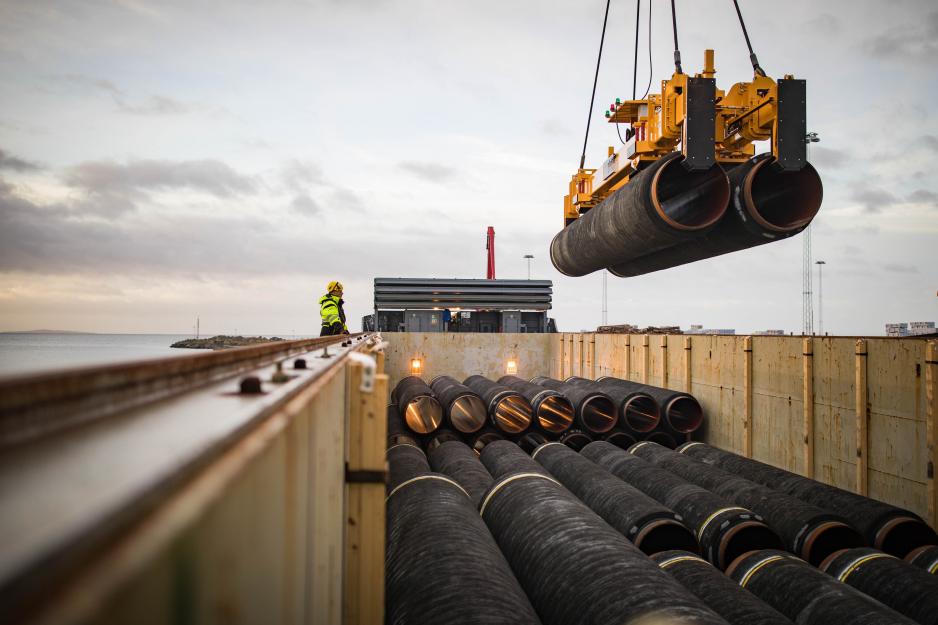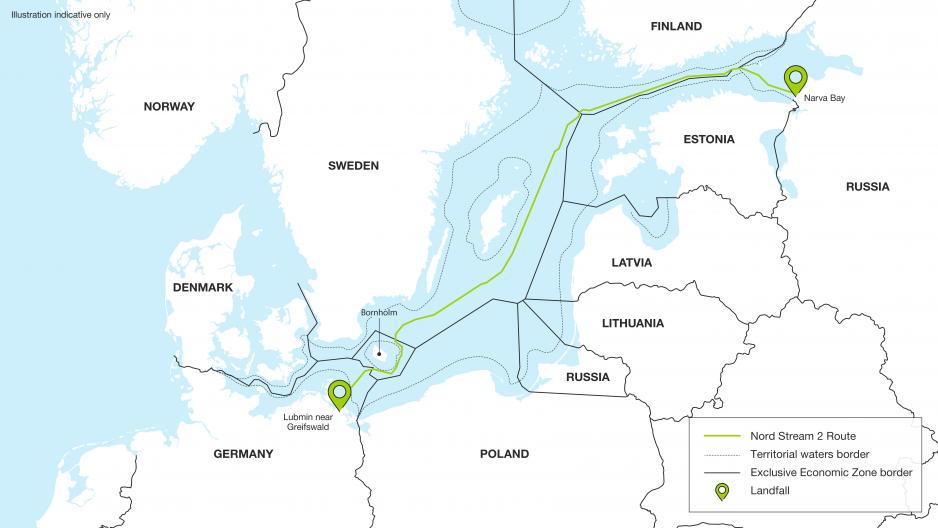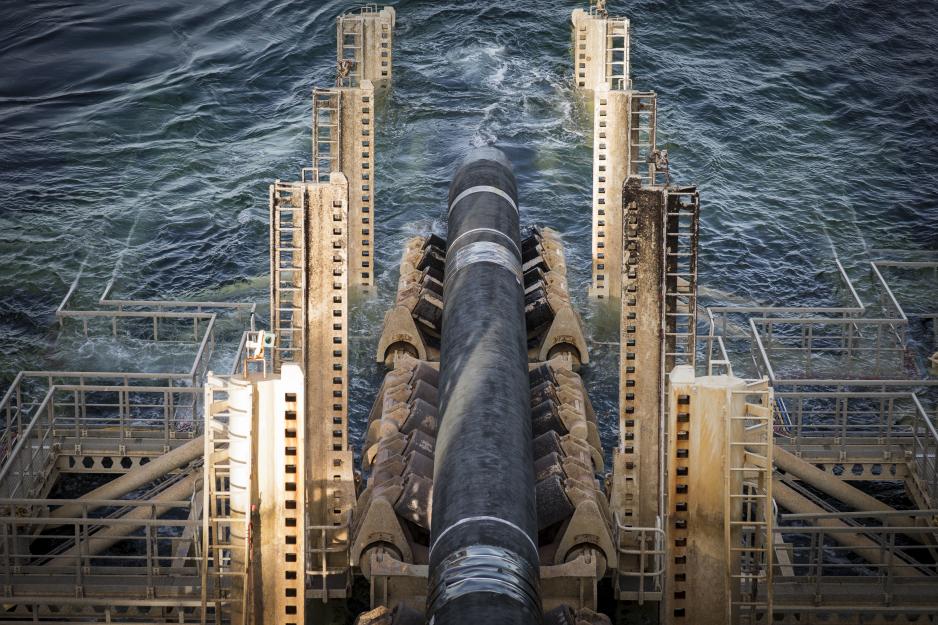Russian Gas Increasingly Important to Europe

Russian natural gas imported to the EU is mainly used to warm up flats and boiling potatoes in millions of European homes. Critics fear that Europe is making itself too dependent on Russia when the new North Stream 2 gas pipeline system is ready later this year. The picture shows unloading of the pipe modules weighing 24 tons. Photo: Axel Schmidt / North Stream 2
In five years, the Russian export of natural gas to Western Europe has increased by 40 percent. The new gas pipeline project North Stream 2 will lead to this figure increasing over the next years. Critics fear that Moscow now will have too much influence over European energy policies.
Each pipe segment is 12 meters long and weighs 24 tons. They are placed on the Baltic Sea bed, one by one, from Russia to Germany, in order to increase capacity for exporting Russian gas to the European market.
Russian Gazprom and a series of European energy companies in 2015 agreed on the construction of a 1,230 kilometers long gas pipeline on the seabed from the southern side of the Gulf of Finland in Russia to Lubmin in Germany. The pipeline has been named North Stream 2 and is placed alongside the since-2012 operative North Stream pipeline, which holds a capacity of 55 billion cubic meters of gas annually.
For years, gas pipelines bringing Russian gas directly to Germany, circumventing East European land, has been a challenging political issue for the EU, and one that has created division amongst past allies.
The background for the construction is simple: The need for import increases while European countries simultaneously produce less gas.
And the world’s second-largest producer of natural gas, second only to the USA, is Russia and it has a lot to offer. But where to draw the line for how energy dependent on Russia Europe wants to become? European capitals are fully aware that Russia repeatedly has used gas as a political tool towards both neighbors like the Ukraine and Belarus.
“Russia needs more export capacity to Europe and wants to become less dependent on using the Ukraine as a transit country. That is why this pipeline has been a hot topic, as an important argument against its construction has been that Ukraine no longer will make money from Russian gas transiting the country on its way to Western Europe”, says Arild Moe, researcher at the Fridtjof Nansen Institute who is currently relevant with his new book “The Globalization of Russian Gas”.

North Stream 2 runs alongside with the existing gas pipeline North Stream from the Gulf of Finland to the North German city of Lubmin. Photo: North Stream
Gas conflict with Ukraine
When the winter was at its coldest both in 2006 and 2009, Russian gas in transit across Ukrainian territory stopped. Both times it was about two things; one about how much Russian Gazprom, in reality a state-owned company with monopoly on exporting natural gas from Russia, should pay to use the Ukraine as a transit country; and the second about how much Ukrainian authorities should pay for strongly subsidized Russian gas to Ukrainian households – which in turn gave Moscow political influence.
The production of natural gas in EU states dropped with 8.1 percent from 2017 to 2018, according to statistics from Eurostat. This has been a downward spiraling trend for years. At the same time, Europe has increased its export of Russian natural gas since 2013 by 40 percent, according to figures from the book “The Globalization of Russian Gas”.
In 2018, Russia exported 243 billion cubic meters of natural gas. This equals one third of the accumulated EU import. By comparison, Norway exported approximately 120 billion cubic meters in 2018.
The reason for Russia’s increasing significantly over the past few years is the country’s having been flexible about the price, says Arild Moe at the Fridtjof Nansen Institute. He refers to gas prices today being regulated through the spot market. Earlier, gas prices were lagging more and the price of natural gas was closer tied to the oil price.
“European gas consumption has not increased much over the past few years. However, the internal gas production is decreasing, which increases the need for import. There are several options, in particular liquefied natural gas, LNG. However, LNG is more expensive than natural gas delivered through pipelines. And when it comes to pipeline gas, there are not many alternatives besides Russia. Norway delivers the volumes it has and the forecasted outlooks for more gas from Africa are not uplifting”, Moe says.

The Swiss operator placing the pipes on the seabed stopped working immediately upon the USA’s announcing sanctions against North Stream 2 just before the end of 2019. The project is thus postponed and will only open towards the end of 2020. Photo: Axel Schmidt / North Stream 2
Russian gas to Europe
The EU is becoming an increasingly important market for Russian natural gas supplied through pipelines. 39 percent of the EU’s total gas import in 2017 came from Russia, according to figures from Eurostat.
Russia is the world’s second-largest producer of gas, second only to the USA. In 2018, Russia exported 243 billion cubic meters of gas through pipelines.
The country also exported 24 billion cubic meters of so-called LNG; liquefied natural gas. In comparison, Norway exported 6.6 billion cubic meters of LNG.
The construction of a new pipeline system, North Stream 2, along the seabed of the Gulf of Bothnia will strongly increase Russian gas export to Europe. Following American sanctions affecting the project before the end of 2019, the opening of the pipeline has been postponed towards the end-of-year 2020.
Mutual dependence
EU’s member states in East Europe are the most skeptical ones towards the North Stream 2 project. Historically, these states have a rather strained relationship with Russia, says Senior Researcher Jakub Godzimirski at the Norwegian Institute of International Affairs (NUPI).
“The reactions against the pipeline project are understandable and dependent on the countries. Those who are the most critical are countries that have historically bad experiences with Russia, whereas the most positive countries are those who benefit the most, like Germany, which sees this as a golden economic opportunity. Nevertheless, the gas pipeline is related to a series of important political issues”, says Godzimirski.
These political issues can for instance be that one supplier gets a too large part of the market. Because there are both historical, political and economic reasons why one does not want to be that dependent on one single energy supplier, Godzimirski points out.
“When you buy a crucial product from a country, you make yourself dependent on that country both economically as well as politically, to some extent. There is, to a certain degree, a question of mutual dependency in which a good relationship is in everyone’s interest. Gas goes one way, money the other. The average understanding will be that both Russia and the EU will be completely dependent on each other in the North Stream project. This dependency can be used and abused by some. Germany is well aware of that risk, though if the agreement were to be used politically by Russia, that would only happen once and mean the end of all energy collaboration between the two countries”, says Godzimirski.
Even though EU skepticism has increase in the past years, the project is nevertheless carried through by Germany, Europe’s economic machine, and large energy corporations in a series of European countries, such as German Uniper and Wintershall, Austrian OMV, French Engie and British-Dutch Shell. In addition there is Russian Gazprom, where the Russian state holds a majority of the shares.
Ukrainian gas independence
Another political issue is the fact that North Stream in the longer run will lead to Ukraine making less money from Russian gas exports. Large parts of Russian gas export currently runs across Ukrainian pipelines, which means significant revenues for the Ukrainian state.
From the West European side, it has been important to demonstrate solidarity with the Ukraine. Ukraine and Russia have now agreed on a new transit agreement that runs through the next five years.
However, the Ukraine has managed to distance itself from Russian gas in later years, Arild Moe points out.
“The current situation is different from what it was only five years ago. Ukraine has managed to become almost independent from direct import of Russian gas for its own consumption. This is done through buying back Russian gas from Europe. Secondly; as the total amount of Russian gas exported to Europe has increased, Russia will still depend on transiting rather large volumes of gas through Ukraine, even when North Stream 2 is completed. North Stream 2 cannot fully replace the Ukraine, and that has given Ukraine a better negotiating position than originally expected”, Moe says.
The USA has recently issued very critical statements against the North Stream project. The USA considers the pipeline a threat to the market position of American LNG. On 21 December last year, President Donald Trump approved American sanctions against companies involved with the construction of the pipeline. That lead to the Swiss company Allseas, which places the pipes on the seabed, to immediately halt its work.
The construction of North Stream 2 is nearly complete, however, the halt to the work means the project will become more expensive as well as delayed. The original project price was estimated at EUR 9.5 billion. Russian authorities hope to open the North Stream 2 towards the end of this year.
This article was originally published in Norwegian and has been translated by HNN's Elisabeth Bergquist.

